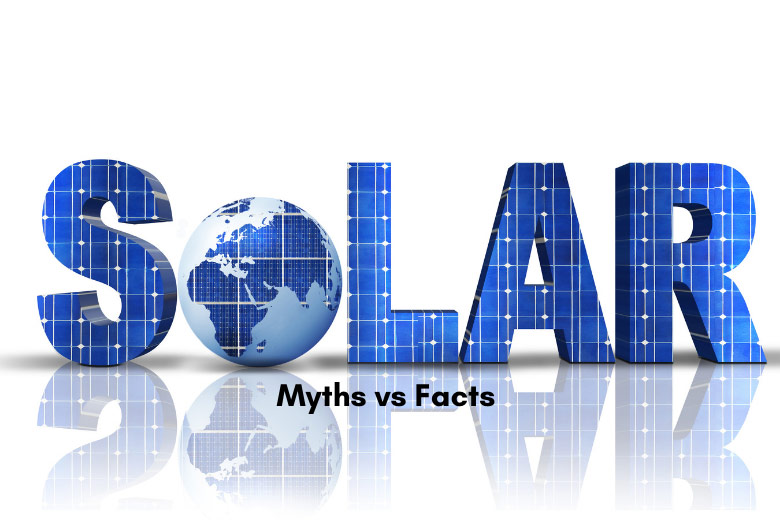Solar Energy – Top 5 Myths versus Facts
4PEL Staff
June 2021

INDIA’s RELATIONSHIP WITH SOLAR ENERGY
India is abundantly blessed with solar radiation, getting as much as 300 days of sunshine annually. Not only is solar power cheaper, its the most abundant source of clean energy – making it an ideal source of electricity across consumer segments like residential, commercial, retail and industrial.
The government is betting big on India’s energy transition story and many companies have also kickstarted their sustainability journey – despite this, capacity addition is not happening at the ideal pace.
Given that India is home to 9 out of 10 most polluted cities in the world – here are some of the misconceptions about Solar Energy that need to be busted to accelerate our country’s green energy adoption.
MYTH 1: SWITCHING TO SOLAR POWER IS AN EXPENSIVE PROPOSITION
FACT: In India, tariffs for solar power are nearly 40-50% cheaper than electricity from the grid. To boost residential consumption – a whole slew of policy measures and incentives have been lined up by respective state governments.
Commercial & Industrial users have realised that on-site solar, as well as off-site solar solutions cans be customised to suit specific energy requirements. In the CAPEX model, the capital investment is often recovered within 3-4 years of commissioning of the solar plant and in the OPEX (or pay per unit consumption) model, tariffs are again 40-60% lower than thermal power.
Over the past decade – better efficiency of solar modules, increased production and declining raw-material prices have led to a sharp downturn in solar tariffs, making it one of the cheapest, cleanest and most abundant sources of energy.
MYTH 2: ELECTRICITY GENERATION OR ENERGY OUTPUT FROM SOLAR PANELS IS ERRATIC
FACT: Solar panels convert light that falls on its surface into electricity. The efficiency of panels depends upon factors like temperature, shade, orientation and type of solar cells. Studying these inherent conditions prior to design and installation of a solar plant helps ensure maximised generation.
Owing to technology and innovation – trackers are used these days to mount solar panels on; these mimic the movement of the sun and ensure maximum exposure to radiation all through the day. The science behind this system is very similar to how a sunflower follows the direction of sunlight all day. An actuator and hydraulic motor is used to replicate this, thereby significantly increasing electricity output from the modules.
Periodic cleaning of the surface of panels also helps in maximising the efficiency of the plant.
MYTH 3: SOLAR PLANTS INVOLVE HIGH MAINTENANCE BY THE CONSUMER
FACT: Solar installations have a lifetime of 20-25 years and require very little maintenance through this period. It is a silent source of electricity, does not involve moving parts which rules our the possibility of too much friction or wear and tear.
Periodic cleaning of the surface or solar modules, especially during seasons when dust tends to accumulate or there is heavy fog – is practically the only maintenance that is essential for your solar plant.
In the case of large-scale commercial and industrial installations, most vendors offer a 5-year O&M (operations and maintenance) contract, that can be renewed on an annual basis post its expiry. The ease of cleaning of modules has a lot of C&I consumers also deciding to opt for self-cleaning of the installation, post the initial 5-year O&M contract. Solar panels are as hassle-free as it can get.
MYTH 4: MANUFACTURING OF SOLAR PANELS IS AN EMISSIONS-INTENSIVE PROCESS; WHICH OFFSETS ANY KIND OF LOW-CARBON BENEFITS FROM ITS USAGE
FACT: Like in the case of most manufacturing processes, CO2 is emitted while producing solar panels as well – the levels of CO2 are about 70 grams per kWh generated. In reality, within 2-3 years – a solar panel tends to generate as much power to offset the CO2 that was released in the manufacturing process. And remember, they still have a life span of at least 20 more years, making them ‘carbon negative’ in the long-term.
It is also essential to factor in that during their lifetime solar panels still produce less than 30 times the CO3 than their thermal counterparts, making it a more sustainable, environment-friendly alternative.
At the same time, it is the responsibility of solar developers as well as consumers to start thinking of solar waste disposal – understanding what components can be reused, reclaimed or recycled and ensuring proper measures to discard waste are an absolute imperative.
MYTH 5: ROOFTOP SOLAR RESULTS IN PANELS USING UP IDLE SPACE AND RENDERING IT USELESS
FACT: Rooftop solar is the easiest way to convert idle roof space into revenue-generating electricity assets. In the case of residential consumers in India – houses rarely need more that 3-5 kW systems, to successfully run all appliances. A typical 1 kW system needs only about 100 sq.ft of roof space. In most urban household, this translates to only 50% of the available terrace space.
Another solution is to build super-elevated structures to mount the solar panels, which not only results in revenue-generating assets, but also acts as a shade or semi-roof during hot, Indian summers. As per the Central Government’s order, and special order by most of the States, authorities have amended the building by-laws to allow for such elevations for erection of solar systems.
For businesses, converting their tin-shed or RCC roofs, that have no real utility value otherwise – into electricity-generating assets helps boost their bottom-line by reducing electricity costs, thereby reducing operational costs. The resultant clean energy is also a great measure of their Sustainability goals.
ULTIMATE FACT – SWITCH TO SOLAR: IT IS EASIER ON YOUR POCKET AND MUCH BETTER FOR THE PLANET. It is time to put that abundant sunshine we receive all year long, to good use!